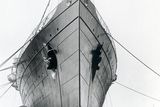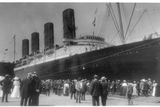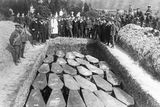Cork to mark Lusitania anniversary with special events
Sinking by U-boat off Cobh coast led to loss of around 1,200 lives



Special ceremonies will take place in Cork to mark the 109th anniversary of the sinking of the RMS Lusitania off the south-west coast during World War I.
The liner, which was torpedoed by a German U-boat, sank off the Old Head of Kinsale with the loss of almost 1,200 passengers and crew on May 7, 1915.
It was one of the events instrumental in eventually bringing the United States into the conflict.
The Lusitania tragedy will be commemorated in the Cork harbour town of Cobh today with a series of special events organised by Cobh Tourism.
Many of those who died in the tragedy were buried in Cobh.
One of the most iconic photographs of World War I is of the three mass graves of 145 Lusitania victims at Cobh’s cemetery.
A total of 80 of the victims, whose bodies were recovered from the sea off the Cork coast, were never identified.
The memorial ceremonies will commence at the Lusitania graves in the Old Church Cemetery at 2.30pm today.
Following prayers, musical honours by the Commodore Male Voice Choir and the laying of wreaths, the proceedings will move to Cobh town centre where a Colour Party from the ONE and representatives of the Royal Naval Association and other maritime and historical groups will assemble at 3.15pm at the Lusitania Peace Memorial in Casement Square.
The ceremonies here will include a wreath-laying ceremony and members of the public are encouraged to attend.
Special events will include lectures on the liner, while special exhibits are also planned at the Lusitania Museum in Kinsale.
A decade ago, the millionaire US owner of the Lusitania wreck signed it over to a Cork historical group which operates the special Lusitania museum.
US businessman Gregg Bemis signed over the World War I wreck to the Kinsale committee with the not-for-profit Old Head of Kinsale museum containing the world’s mostdetailed exhibit on the sinking of the liner.
The US businessman said he was “very impressed” by the work undertaken over many years by the Kinsale museum backers.
He also said he believed they were best placed to preserve the Lusitania’s legacy for future generations.
Mr Bemis had donated multiple artefacts to the museum over the years which had been recovered from dives on the wreck site. “I believe in the integrity of history. They have done a great job at the museum,” he said.
Cork historian Michael Martin said it was fitting recognition of the remarkable work undertaken over many years in Kinsale to commemorate the liner.
“They have worked tirelessly over the years to preserve the history and legacy of the Lusitania. They (the museum officials) have also done it in a very respectful way,” he said.
For decades, Mr Bemis had championed the historical exploration of the wreck to determine precisely why the famous liner sank so fast after being struck by a single German U-boat torpedo in 1915 as it steamed off the Old Head of Kinsale.
The New Mexico businessman had acquired an interest in the World War I wreck in 1968 and in 1982 became sole owner of the wreckage and its salvage rights.
Mr Bemis had described as “a tragedy for Ireland” the fact a full expedition did not take place in 2015 to mark the centenary of the Lusitania’s sinking.
RMS Lusitania sank 18km off the Cork coast on May 7, 1915, after being struck by a single torpedo from the German submarine, U-20.
However, a second internal explosion minutes later dramatically accelerated the rate of sinking – and cost hundreds more lives.
Mystery has surrounded the cause of the second explosion, with theories linking it to munitions being carried on the liner, igniting dust in a coal bunker or a giant boiler exploding.
The liner was carrying almost 60 tonnes of munitions bound for Britain from the US. A total of 1,198 people died, with just over 700 being saved.
Mr Bemis said in 2014 that impossible dive conditions were frustrating ongoing attempts to determine once and for all what caused the catastrophic second explosion. “I want to solve the mystery of the second explosion that caused the liner to sink so fast with such heavy loss of life and bring to amuseum some of the artefacts of the second most famous wreck in history after the RMS Titanic,” he said.
Join the Irish Independent WhatsApp channel
Stay up to date with all the latest news

















